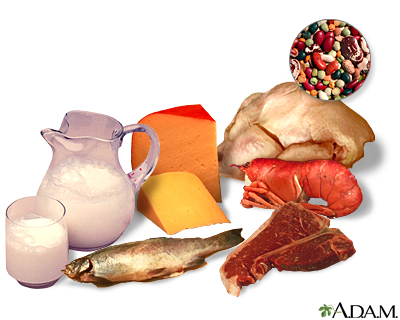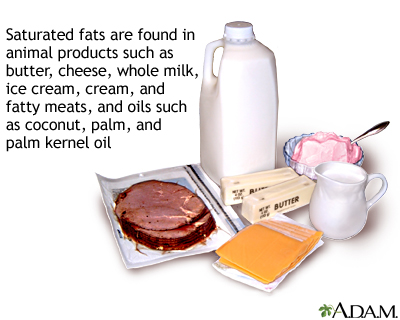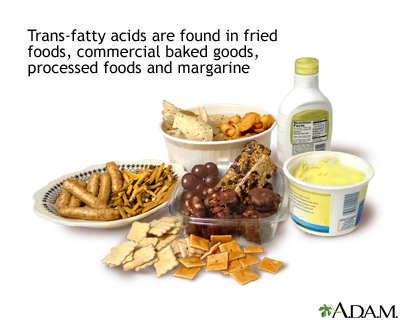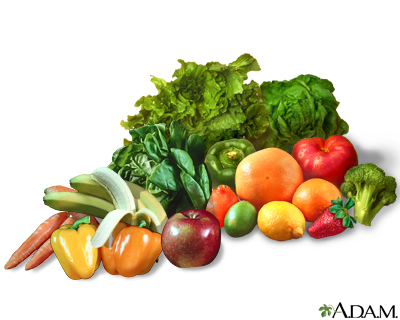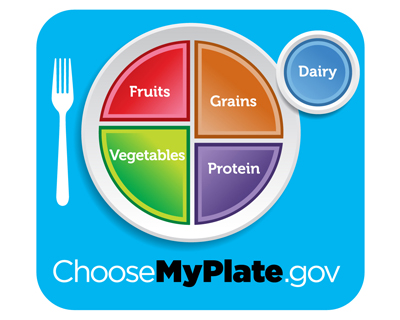Managing your weight with healthy eating
Obesity - managing your weight; Overweight - managing your weight; Healthy diet - managing your weight; Weight loss - managing your weightThe foods and drinks you choose are important for maintaining a healthy weight. This article offers advice on making good food choices to manage your weight.
A Balanced Diet
For a balanced diet, you should choose foods and drinks that offer good nutrition. This helps keep your body healthy.
Know how many calories your body needs every day. A dietitian can help you determine your caloric needs based on your:
- Age
- Sex
- Size
- Activity level
- Medical conditions
Know how many servings of dairy, fruits and vegetables, proteins, grains, and other starches your body needs each day.
A balanced diet also includes avoiding too much of some foods and making sure you get enough of others.
Stock up on healthy foods such as fresh produce, lean proteins, low-fat dairy, and whole grains. Limit foods with "empty calories." These foods are low in healthy nutrients and high in sugar, fat, and calories, and include items such as chips, candy, and regular sodas. Instead, focus on choosing snacks with fiber and protein like carrots, celery, or bell peppers with hummus, an apple and a piece of string cheese, or yogurt with fresh fruit.
Choose different healthy foods from each food group. Eat foods from each group with every meal. Whenever you sit down to a meal, fruits and vegetables should take up half of your plate.
Protein (meats and beans)
Avoid the fried options; baked, steamed, grilled, stewed, or broiled are lower in calories and saturated fat.
Good sources of lean protein include white meat turkey and chicken with the skin removed. Buffalo meat is also a lean option.
Eat lean cuts of beef or pork. Trim away any visible fat.
Eat fish, especially fatty fish such as salmon and sardines, at least 2 times per week. Limit varieties that are high in mercury, such as:
- Shark
- Swordfish
- Tilefish
- King mackerel
Also limit red snapper and tuna to once a week or less.
Plant-based proteins are part of a balanced diet and often good sources of additional fiber. Examples are nuts, seeds, and soy (including edamame, tofu, and tempeh). Another good source is beans and legumes, including:
- Pinto beans
- Black beans
- Kidney beans
- Lentils
- Split peas
- Garbanzo beans
Eggs are also a good source of protein. For most healthy people, it is fine to eat 1 to 2 whole eggs per day. The yolk is where most of the vitamins and minerals are.
Dairy (milk and milk products)
Always choose fat-free (skim) or low-fat (1%) dairy products and try to consume 3 cups (0.72 liters) total per day. Be careful with flavored milks that may contain added sugars. Yogurt is best when it is fat-free or low-fat. Plain yogurt that you stir your own fresh or dried fruit into is better than fruit-flavored yogurts, which can contain added sugars.
Cream cheese, cream, and butter are high in saturated fat and should be consumed in moderation.
Grains, cereals, and fiber
Grain products are made from wheat, rice, oats, cornmeal, barley, or other grains such as millet, bulgur, and amaranth. Foods made with grains include:
- Pasta
- Oatmeal
- Breads
- Breakfast cereals
- Tortillas
- Grits
There are 2 kinds of grains: whole grains and refined grains. Choose mostly whole-grain foods. They are healthier for you because they have the entire grain kernel and have more protein and fiber than refined grains. These include:
- Bread and pasta made with whole-wheat flour
- Bulgur (cracked wheat), amaranth, and other grains
- Oatmeal
- Popcorn
- Brown rice
Check the ingredients list and buy breads and pastas that list "whole wheat" or "whole grain" as the first ingredient.
Refined grains are changed to make them last longer. They also have a finer texture. This process removes fiber, protein, iron, and many B vitamins. These foods not only have less nutritional value, but they are also often less filling so you may feel hungry again sooner. Refined grains include white flour, white rice, or de-germed cornmeal. Eat fewer foods containing refined grains, such as white flour and pasta.
Products with added bran, such as oat bran or bran cereal, are a good source of fiber. Just remember, they may not be whole-grain products.
Oils and fats
Monounsaturated or polyunsaturated fat. These are the healthiest type of fat. Many healthy oils come from plants, nuts, olives, or fish. They are liquid at room temperature.
Healthy choices include:
- Canola
- Corn
- Cottonseed
- Olive
- Safflower
- Soybean
- Sunflower oils
Saturated fats. These are fats found mostly in animal products such as butter and lard. They are also found in coconut oil. Saturated fats are solid at room temperature. It is best to try and reduce the amount of saturated fat in your diet.
You can limit your intake of these fats by eating only a small amount of:
- Whole milk products
- Cream
- Ice cream
- Butter
- Snack foods such as cookies, cakes, and crackers that contain these ingredients
Trans fats and hydrogenated fats. This type of fat is often found in fried foods and processed foods such as donuts, cookies, chips, and crackers. Many margarines also have them. The recommendation is to limit your intake of trans fats to as close to zero as possible.
Things you can do to help limit your intake of unhealthy saturated fats and trans fats include:
- Limit fried foods. Fried food absorbs the fats from cooking oils. This increases your fat intake. If you do fry, cook with polyunsaturated oils. Try to sauté foods in a small amount of oil instead of deep-fat frying.
- Boil, grill, poach, and bake fish, chicken, and lean meats.
- Read food labels. Try to avoid foods that have partially hydrogenated fats or trans fats. Limit foods that are high in saturated fats.
Fruits and Vegetables
Many fruits and vegetables are low in calories and are also packed with fiber, vitamins, minerals, and water. Adequate intake of fruits and vegetables can help you control your weight. It may also reduce your risk of cancer and other diseases.
The fiber and water in fruits and vegetables helps fill you up. Including more fruits and vegetables in your diet can lower the calories and fat in your diet without leaving you feeling hungry.
Limit fruit juices to one 8 fl-ounce (0.24 liters) cup or less per day. Whole fruits and vegetables are a better choice than juices because juices do not have the fiber to help fill you up. They often have added sugar, as well.
Divide your dinner plate. Fill half your plate with fruits and vegetables. Fill the other half with whole grains and meat.
Replace half of the cheese in your omelets with spinach, onions, tomatoes, or mushrooms. Replace 2 ounces (56 grams) of cheese and 2 ounces (56 grams) of meat in your sandwiches with lettuce, tomato, cucumbers, or onions.
You can reduce your portion of rice or pasta by stirring in broccoli, chopped bell pepper, cooked squash, or other vegetables. Many stores now sell "riced" cauliflower and broccoli that can be used along with or in place of rice to increase your vegetable intake. Use frozen vegetables if you do not have fresh ones. People who are on a low sodium diet may need to limit their intake of canned vegetables.
Healthy Eating Tips
Limit snacks that have low nutritional benefits, such as cookies, cakes, chips, or candy.
Make sure you are drinking enough water, at least 8 cups (2 liters) per day. Limit sugar-sweetened beverages such as sodas and sweet teas.
For more information visit www.choosemyplate.gov.
References
Arnett DK, Blumenthal RS, Albert MA, Buroker AB, et al. 2019 ACC/AHA guideline on the primary prevention of cardiovascular disease: a report of the American College of Cardiology/American Heart Association Task Force on Clinical Practice Guidelines. Circulation. 2019;140(11):e596-e646. PMID: 30879355 pubmed.ncbi.nlm.nih.gov/30879355/.
Freeland-Graves JH, Nitzke S; Academy of Nutrition and Dietetics. Position of the academy of nutrition and dietetics: total diet approach to healthy eating. J Acad Nutrition and Dietetics. 2013;113(2):307-317. PMID: 23351634 pubmed.ncbi.nlm.nih.gov/23351634/.
Hensrud DD. Diet and nutrition. In: Goldman L, Cooney KA, eds. Goldman-Cecil Medicine. 27th ed. Philadelphia, PA: Elsevier; 2024:chap 13.
US Department of Agriculture and US Department of Health and Human Services. Dietary Guidelines for Americans, 2020-2025. 9th Edition. www.dietaryguidelines.gov/sites/default/files/2020-12/Dietary_Guidelines_for_Americans_2020-2025.pdf. Updated December 2020. Accessed September 23, 2024.
Proteins - illustration
Protein is an important nutrient that builds muscles and bones and provides energy. Protein can help with weight control because it helps you feel full and satisfied from your meals. The healthiest proteins for weight maintenance are the leanest, meaning they have less fat and calories than other choices. The leanest protein choices are fish or shellfish, skinless chicken or turkey, low-fat or fat-free dairy (skim milk, low-fat cheese). The leanest red meat cuts are loin and tenderloin. Other healthy options are plant-based proteins.
Proteins
illustration
myPlate - illustration
The U.S. Department of Agriculture's food guide, called MyPlate, encourages consumers to make healthier food choices. The guide encourages you to make healthy choices and avoid oversized portions. Half your plate should be filled with fruits and vegetables. At least half of your grains should be whole grains. You also should switch to fat-free or low-fat milk.
myPlate
illustration
Healthy diet - illustration
Fat is essential for the proper functioning of the body. However, adults should be aware of the fat content of food, and limit intake of saturated fats.
Healthy diet
illustration
Saturated fats - illustration
Saturated fats are found predominantly in animal products such as meat and dairy products, and can be associated with higher cholesterol levels. Tropical oils such as palm, coconut, and coconut butter, are also high in saturated fats.
Saturated fats
illustration
Trans-fatty acids - illustration
Trans-fatty acids are manufactured fats created during a process called hydrogenation, which is aimed at stabilizing polyunsaturated oils to prevent them from becoming rancid and to keep them solid at room temperature. They may be particularly dangerous for heart health and may pose a risk for certain cancers. Hydrogenated fats are used in stick margarine, fast foods, commercial baked goods (donuts, cookies, crackers), and fried foods.
Trans-fatty acids
illustration
Fruits and vegetables - illustration
A healthy diet includes adding vegetables and fruit every day. Vegetables like broccoli, green beans, leafy greens, zucchini, cauliflower, cabbage, carrots, and tomatoes are low in calories and high in fiber, vitamins, and minerals. Many studies have shown that eating plenty of vegetables is extremely healthy. Try to eat about 3 to 5 servings every day. Fruit is also a good source of fiber, vitamins, and minerals. You should try to eat about 2 to 3 servings of fruit each day.
Fruits and vegetables
illustration
Proteins - illustration
Protein is an important nutrient that builds muscles and bones and provides energy. Protein can help with weight control because it helps you feel full and satisfied from your meals. The healthiest proteins for weight maintenance are the leanest, meaning they have less fat and calories than other choices. The leanest protein choices are fish or shellfish, skinless chicken or turkey, low-fat or fat-free dairy (skim milk, low-fat cheese). The leanest red meat cuts are loin and tenderloin. Other healthy options are plant-based proteins.
Proteins
illustration
myPlate - illustration
The U.S. Department of Agriculture's food guide, called MyPlate, encourages consumers to make healthier food choices. The guide encourages you to make healthy choices and avoid oversized portions. Half your plate should be filled with fruits and vegetables. At least half of your grains should be whole grains. You also should switch to fat-free or low-fat milk.
myPlate
illustration
Healthy diet - illustration
Fat is essential for the proper functioning of the body. However, adults should be aware of the fat content of food, and limit intake of saturated fats.
Healthy diet
illustration
Saturated fats - illustration
Saturated fats are found predominantly in animal products such as meat and dairy products, and can be associated with higher cholesterol levels. Tropical oils such as palm, coconut, and coconut butter, are also high in saturated fats.
Saturated fats
illustration
Trans-fatty acids - illustration
Trans-fatty acids are manufactured fats created during a process called hydrogenation, which is aimed at stabilizing polyunsaturated oils to prevent them from becoming rancid and to keep them solid at room temperature. They may be particularly dangerous for heart health and may pose a risk for certain cancers. Hydrogenated fats are used in stick margarine, fast foods, commercial baked goods (donuts, cookies, crackers), and fried foods.
Trans-fatty acids
illustration
Fruits and vegetables - illustration
A healthy diet includes adding vegetables and fruit every day. Vegetables like broccoli, green beans, leafy greens, zucchini, cauliflower, cabbage, carrots, and tomatoes are low in calories and high in fiber, vitamins, and minerals. Many studies have shown that eating plenty of vegetables is extremely healthy. Try to eat about 3 to 5 servings every day. Fruit is also a good source of fiber, vitamins, and minerals. You should try to eat about 2 to 3 servings of fruit each day.
Fruits and vegetables
illustration
- Weight control and diet - InDepth(In-Depth)
- Exercise - InDepth(In-Depth)
- High blood pressure(Alt. Medicine)
- Diabetes(Alt. Medicine)
- Diabetes - type 2 - InDepth(In-Depth)
- Diabetes - type 1 - InDepth(In-Depth)
- Stress - InDepth(In-Depth)
- Heart failure(Alt. Medicine)
- Stress(Alt. Medicine)
- Heart failure - InDepth(In-Depth)
- Managing your weight with healthy eating
- Managing your weight gain during pregnancy
- Managing your blood sugar
- Exercise and activity for weight loss
- Gestational diabetes - self-care
- Living with heart disease and angina
- Diabetes and alcohol
- Diabetes - preventing heart attack and stroke
- Bile acid sequestrants for cholesterol
- Premenstrual syndrome - self-care
Review Date: 7/24/2024
Reviewed By: Stefania Manetti, RD/N, CDCES, RYT200, My Vita Sana LLC - Nourish and heal through food, San Jose, CA. Review provided by VeriMed Healthcare Network. Also reviewed by David C. Dugdale, MD, Medical Director, Brenda Conaway, Editorial Director, and the A.D.A.M. Editorial team.

